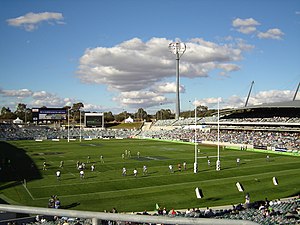| Revision as of 17:33, 3 November 2006 editAngry mob mulls options (talk | contribs)318 editsNo edit summary← Previous edit | Revision as of 22:48, 5 November 2006 edit undoTancred (talk | contribs)Extended confirmed users1,713 edits football is played at the olympicsNext edit → | ||
| Line 28: | Line 28: | ||
| The stadium has played host to several local sporting teams such as the Canberra City Arrows and ] (]) and the shortlived ] (]). In 1990 the athletics track was removed, and the ground then became the home of the ] (]) and, in 1996, the ] (]). | The stadium has played host to several local sporting teams such as the Canberra City Arrows and ] (]) and the shortlived ] (]). In 1990 the athletics track was removed, and the ground then became the home of the ] (]) and, in 1996, the ] (]). | ||
| Further renovations occurred in 1997 in preparation for staging ] matches as part of the ] in ], which also in turn shrank the size of the playing field preventing any future ] games being played on the field. The final cost of the renovations was more than seven times what was originally anticipated by the territory government of the time, and the subsequent controversy ended the career of then Chief Minister ]. During the lead-up, on ] ], unseasonal snow fell during a match between the Raiders and the Wests Tigers, the only such event in ] history, with the snow causing frost damage to the turf intended for the |
Further renovations occurred in 1997 in preparation for staging ] matches as part of the ] in ], which also in turn shrank the size of the playing field preventing any future ] games being played on the field. The final cost of the renovations was more than seven times what was originally anticipated by the territory government of the time, and the subsequent controversy ended the career of then Chief Minister ]. During the lead-up, on ] ], unseasonal snow fell during a match between the Raiders and the Wests Tigers, the only such event in ] history, with the snow causing frost damage to the turf intended for the olympic football tournament. | ||
| == Other events == | == Other events == | ||
| Line 34: | Line 34: | ||
| * ] met ] in an ] match in 1995. | * ] met ] in an ] match in 1995. | ||
| * Matches from the ] were also played at the stadium. | * Matches from the ] were also played at the stadium. | ||
| * Kanga Cup International Youth |
* Kanga Cup International Youth football Tournament. | ||
Revision as of 22:48, 5 November 2006
 | |
| Former names | Bruce Stadium |
|---|---|
| Location | Bruce, Canberra |
| Capacity | |
| Surface | Grass |
| Opened | 1977 |
| Tenants | |
Canberra Raiders, NRL<center\> | |
Canberra Stadium (originally known as Bruce Stadium) is a facility primarily used for the rugby codes, located adjacent to the Australian Institute of Sport in Canberra, the capital of Australia. Bruce is the Canberra suburb where the stadium is located, and in turn Bruce was named after Stanley Bruce, Australian Prime Minister 1923-1929.
Capacity is a nominal all-seated 25,000, the largest crowd being 28,753 for the 2004 Super 12 Final. The main grandstand is named after Canberra Raiders and Australian rugby league player Mal Meninga, and a statue of another Raiders and Australian league representative Laurie Daley adorns the main grandstand entrance.
The stadium is currently owned by the Australian Government through the Australian Sports Commission and leased to the Australian Capital Territory Government. While the current lease is due to expire in 2010, the ACT Government is seeking ownership of the stadium through a land transfer with the Australian Government.
History
Constructed in 1977 for the Pacific Conference Games, it also was the venue for the 4th IAAF World Cup in Athletics. At the latter meet, the fastest 400m for women was recorded by East German Marita Koch - a time that still stands today.
The stadium has played host to several local sporting teams such as the Canberra City Arrows and Canberra Cosmos (soccer) and the shortlived Canberra Bushrangers (baseball). In 1990 the athletics track was removed, and the ground then became the home of the Canberra Raiders (rugby league) and, in 1996, the ACT Brumbies (rugby union).
Further renovations occurred in 1997 in preparation for staging football matches as part of the 2000 Summer Olympics in Sydney, which also in turn shrank the size of the playing field preventing any future Australian Rules games being played on the field. The final cost of the renovations was more than seven times what was originally anticipated by the territory government of the time, and the subsequent controversy ended the career of then Chief Minister Kate Carnell. During the lead-up, on 29 May 2000, unseasonal snow fell during a match between the Raiders and the Wests Tigers, the only such event in National Rugby League history, with the snow causing frost damage to the turf intended for the olympic football tournament.
Other events
- In 1990, the stadium hosted an International Rules match (a combination of Gaelic football and Australian rules football) between Ireland and Australia.
- West Coast Eagles met Fitzroy in an Australian Football League match in 1995.
- Matches from the 2003 Rugby World Cup were also played at the stadium.
- Kanga Cup International Youth football Tournament.
External links
35°15′00″S 149°06′09″E / 35.25000°S 149.10250°E / -35.25000; 149.10250
Categories: